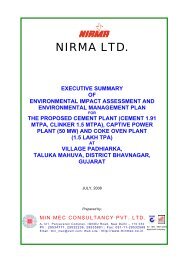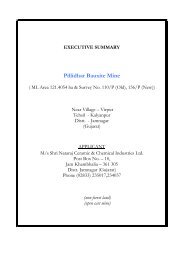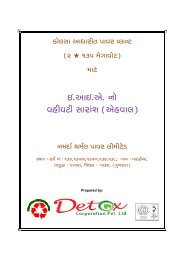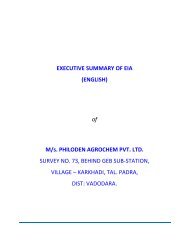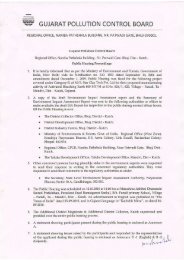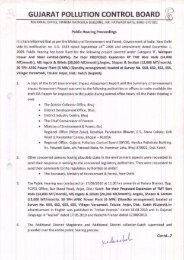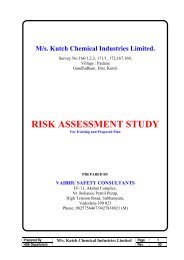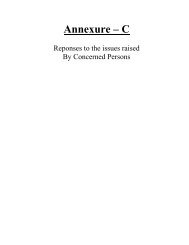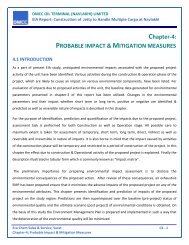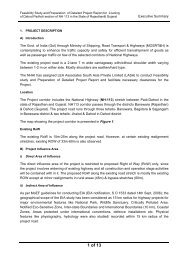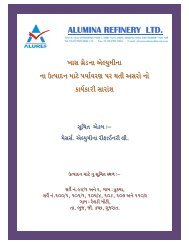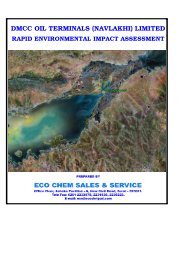4. description of the environment - Gujarat Pollution Control Board
4. description of the environment - Gujarat Pollution Control Board
4. description of the environment - Gujarat Pollution Control Board
Create successful ePaper yourself
Turn your PDF publications into a flip-book with our unique Google optimized e-Paper software.
Final Feasibility Report<br />
Preparation <strong>of</strong> Feasibility– cum-Preliminary Design for 4/6 Laning<br />
<strong>of</strong> Jetpur-Somnath section <strong>of</strong> NH 8D, Package No:<br />
NHAI/DBFOII/DPR/02<br />
Monitoring<br />
Location &<br />
Code<br />
Chainage<br />
(km)<br />
T-Junction 126 + 700<br />
NAAQ Norms*<br />
(8/24 hourly<br />
Mean)<br />
Location<br />
Reference<br />
At T Junction<br />
near Somnath<br />
where <strong>the</strong> road<br />
on RHS goes to<br />
Somnath and on<br />
LHS goes to<br />
Bhavnagar*<br />
Area<br />
Category<br />
Residential<br />
& Rural<br />
VOLUME III:<br />
ENVIRONMENTAL IMPACT ASSESSMENT<br />
Pollutant Concentration (μg/m3)<br />
24 hourly mean values<br />
RSPM TSPM SO2 NO2 HC CO<br />
147.26 27<strong>4.</strong>92 12.24 15.72 Nil 1335<br />
150 500 120 120<br />
The TSPM range is 230.00μg/Nm 3 to 399.00 μg/Nm 3 . The total particulate concentration at 50%<br />
<strong>of</strong> location is less than 288 μg/Nm 3 . The higher concentration <strong>of</strong> TSPM at some locations is due<br />
to higher concentration <strong>of</strong> RSPM in <strong>the</strong> ambient. In most <strong>of</strong> <strong>the</strong> samples, RSPM is 50% higher<br />
than <strong>the</strong> prescribed standard. All gaseous pollutants viz. SO2, NO2, HC and CO are well within<br />
<strong>the</strong> prescribed limit.<br />
<strong>4.</strong>5 WATER ENVIRONMENT<br />
Surface Water: The project region falls in Rajkot<br />
and Junagadh district. Junagadh district is<br />
prosperous in water on account <strong>of</strong> rivers, reservoirs<br />
and lakes. The principal rivers <strong>of</strong> <strong>the</strong> district falling<br />
along <strong>the</strong> project region are Uben, Ojat, Hiren,<br />
Meghal and Raval. The slope <strong>of</strong> <strong>the</strong> district is<br />
towards south. The rivers that cross <strong>the</strong> project<br />
road are– Uben river at Ch 14/200, Lol river at Ch<br />
29/200, Sonrakh river at Ch 30/800, Kalve river at<br />
Ch 35/000, Vali river at Ch 47/000, Ozat river at Ch<br />
48/000, Badodari river at Ch 61/100, Meghal river at<br />
Devka River Crossing <strong>the</strong> Project Road<br />
Ch 102/000 and Devka river at Ch 117/000. All <strong>the</strong> rivers are non perennial, rainfed. The rivers<br />
are used for washing and cleaning. The hydrology <strong>of</strong> <strong>the</strong> project area is depicted in Figure 4-8.<br />
Ground Water: As per <strong>the</strong> discussion with <strong>the</strong> <strong>of</strong>ficials <strong>of</strong> <strong>Gujarat</strong> <strong>Pollution</strong> <strong>Control</strong> <strong>Board</strong>, <strong>the</strong><br />
talukas falling in <strong>the</strong> project <strong>of</strong> both Rajkot and Junagadh districts are in Grey zone (restricted<br />
zone). This categorization is attributed to <strong>the</strong> level <strong>of</strong> extraction <strong>of</strong> ground water against<br />
increased domestic, industrial and irrigation requirements. The extraction is higher in <strong>the</strong> region<br />
<strong>of</strong> Saurashtra.<br />
In <strong>the</strong> year 2002, both <strong>the</strong> districts were categorised as Grey zone and <strong>the</strong> availability <strong>of</strong> <strong>the</strong><br />
ground water along <strong>the</strong> corridor varied between from 5 to 20 m below ground level (bgl) during<br />
pre-monsoon (May 2002), while during post monsoon (November 2002) it has varied from less<br />
than 5 to 10 m bgl . Ground water depth mostly depends on aquifer geology, geomorphology and<br />
4-12



